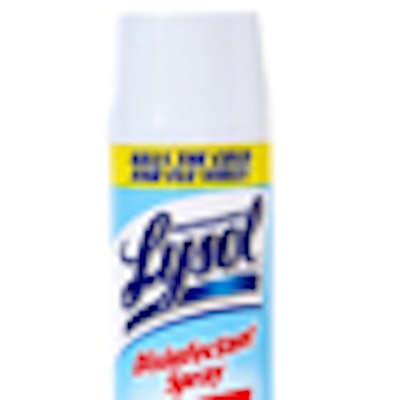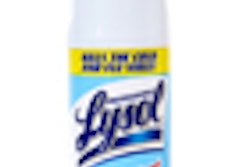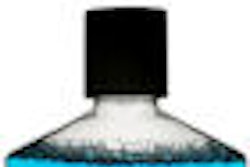
A study in the Journal of the American Dental Association that measured the long-term effect of six spray disinfectants on nine common types of dental office surfaces found that Birex SE had better blood removal scores across time than other tested products (May 2012, Vol. 143:5, pp. 472-477).
The study, which was supported in part by funding from Biotrol, the manufacturer of Birex, also found that enameled metal and smooth and textured vinyl surfaces became harder to clean over time.
A disinfectant that causes the surface to degrade could make the surface not only aesthetically unpleasing but also harder to clean and disinfect over time, noted study author Charles John Palenik, PhD, director of scientific affairs and research at the Organization for Safety, Asepsis, and Prevention.
"There is not a lot of literature on how disinfectants affect dental surfaces," Palenik told DrBicuspid.com. "I looked at how different cleaners affect the quality of the surfaces in a dental office over an extended period of time."
Surface deterioration
For this study, Palenik tested nine common dental surfaces: smooth vinyl, textured vinyl, brushed aluminum, smooth stainless steel, laminated heat-resistant thermosetting plastic, service line rubber hosing, high-impact plastic, acrylic resin sheets, and enameled metal.
He used six disinfectants: Birex SE Concentrate (Biotrol), CaviCide spray (Metrex), regular bleach diluted 1:10 with tap water, DisCide Ultra disinfecting spray, (Palmero Health Care), Lysol Brand II IC disinfectant spray (Reckitt Benckiser), and Opti-Cide3 (Biotrol). Tap water served as a nonchemical control.
Each surface-disinfectant pairing had 10 samples, each a 10-cm square at least 20-mm thick, except for the service line rubber hosing, which was 15-cm long.
“Many of the products were not highly effective in removing blood.”
— Eve Cuny, MS
Palenik used the standard spray-wipe-spray method, and each surface was disinfected 1,920 times -- an estimate of the number of cleanings per year at a dental practice.
After every 100 disinfections, he conducted blood removal testing of the surfaces, which monitored residual blood and disinfectant cleaning ability.
To test this, Palenik covered the center (1 cm2) of each sample with 0.1 mL of defibrinated sheep blood and let the thin film dry for 60 minutes. He then disinfected the surface and obtained a sample of it to test for residual blood.
After comparing the test products' results to the control's results, Palenik found that Birex SE had consistently better blood removal scores across time. DisCide Ultra disinfecting spray had the poorest blood removal results, he noted, while CaviCide and Opti-Cide3 had similar blood removal scores.
Palenik also conducted tests to compare initial cleaning scores with those obtained after 1,920 disinfection procedures. The use of Opti-Cide3 resulted in the fewest significant differences, followed by the use of Birex SE and the control. Diluted bleach affected the surfaces the most. The other three disinfectants had results that varied according to the disinfected surface.
Ideally, a disinfectant should produce results that mimic those of water's effect on the surface over time, Palenik noted.
"The closer the cleaner came to the results we got with water, the happier we were," he said.
After undergoing long-term disinfection, some surfaces remained relatively easy to clean, while smooth and textured vinyl and enameled metal became harder to clean.
"I did expect that the chemicals would have an effect on the integrity of the surface, and there was some incompatibility between surface and products -- for example, bleach was not compatible with metal," Palenik said.
Disinfecting or covering?
Dental offices may want to avoid using enameled metal surfaces, or, in the case of vinyl, use plastic protective barriers instead of requiring the surfaces to undergo multiple disinfection procedures, Palenik added.
Eve Cuny, MS, an assistant professor and director of environmental health and safety at the University of Pacific Arthur A. Dugoni School of Dentistry, agreed that using barriers that cannot be penetrated by fluids and that can be changed between patients might work better with enameled metals and vinyl in the dental office.
"Because the selection of the material with which to manufacture dental equipment and surfaces can depend on many factors, selection based upon the effect of disinfectants alone would not be reasonable," she told DrBicuspid.com. "Rather, knowing when materials are better suited to the use of barriers is probably a more reasoned approach."
These study results help confirm what has often been suspected, she added: Repeated use of chemical germicides combined with the physical activity of wiping and rubbing will have a negative effect on some surfaces in dental operatories.
"This study helps us understand which materials used in dental equipment and operatory surfaces may be more vulnerable to damage and whether that damage could have an effect on cleanability," Cuny said. "What I found surprising was that it appears many of the products were not highly effective in removing blood even from new surfaces."
Clinicians should choose disinfectants both for their ability to clean efficiently and the effect they have on the deterioration of surface materials, she added.
Although Palenik used the spray-wipe-spray technique in the study, he noted that there has been a move away from that technique to wipe-discard-wipe. His next study will focus on that technique, specifically looking at what wipes do to surface integrity and what quantity is needed for cleaning.



















